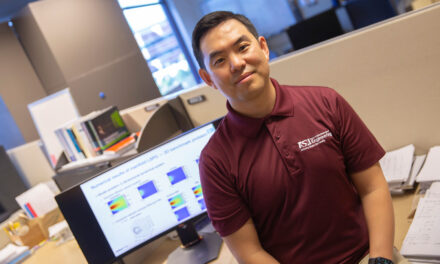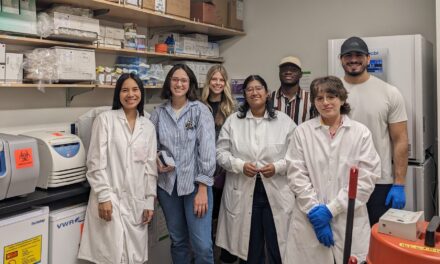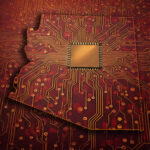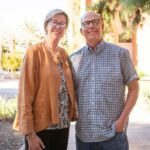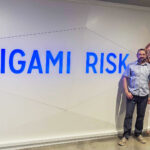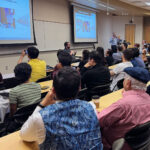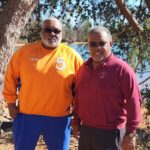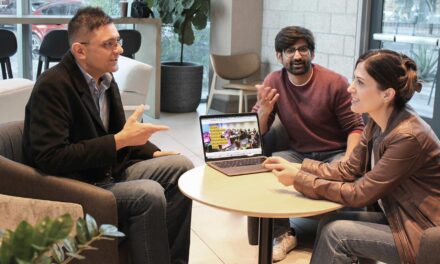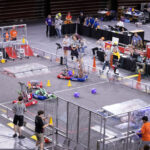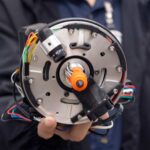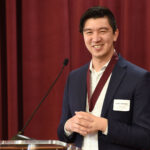
Solar energy graduate program teaches all aspects of the industry
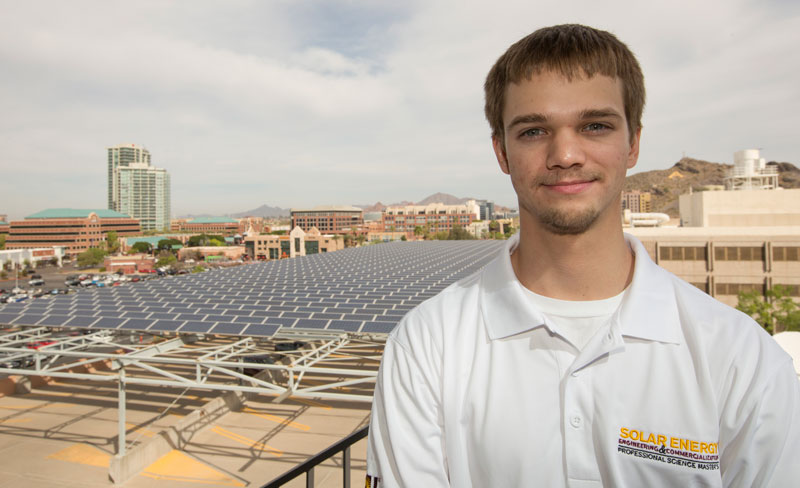
Above: Nicholas Fortenberry, a student in the Solar Energy Engineering and Commercialization Professional Science Master’s program stands in front of one of the many solar energy module systems on ASU’s Tempe campus. Photographer: Pete Zrioka/ASU
Jobs in the solar energy field are on an upward trajectory, and there’s a lot of room for the industry to grow with solar power currently accounting for only about one percent of total power generation in the United States.
It’s an especially appealing industry in a sunny location like Arizona, and Arizona State University has taken advantage of that benefit by developing the largest solar energy portfolio among all universities in the country.
ASU’s Ira A. Fulton Schools of Engineering also has a unique graduate studies program to give engineering and non-engineering students to gain a comprehensive education on the solar industry. The Professional Science Master’s (PSM) in Solar Energy Engineering and Commercialization (SEEC) enables students to get an understanding of solar energy technology and engineering as well as business, policy and nontechnical aspects of the field, preparing them to be successful in solar development and commercialization. It’s a relatively new type of graduate program designed to be completed in 12 months for students interested in graduate studies, but not necessarily interested in a doctoral degree or an MBA.
Nicholas Fortenberry, a PSM SEEC student finishing the program this summer, became interested in solar energy during high school when he took part in international humanitarian projects in several countries around the world. During trips for those projects he noticed the lack of electricity was a common problem among impoverished communities.
“My passion for solar stemmed from these experiences because of its potential to solve people’s problems,” Fortenberry says. “As an engineer, seeing a need and then the potential of a particular technology to meet that need gives me motivation to be a part of the effort to make that technology more obtainable for the masses.”
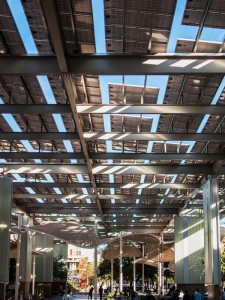
The Power Parasol structure of solar modules near the Memorial Union at ASU. Photographer: Cheman Cuan/ASU
Students learn technical and nontechnical skills
After earning his bachelor’s degree in mechanical engineering at Georgia Southern University, Fortenberry looked for programs to continue his education in solar energy. He began a master’s in mechanical engineering at Texas A&M University hoping to focus on solar energy, but transferred to ASU and the PSM SEEC program because he found ASU to be the only university with a continuing education program with engineering professors dedicated to all facets of the solar industry.
“ASU’s program allowed me to find professors dedicated to not only certain aspects of solar energy, but the whole industry from multiple viewpoints,” Fortenberry says. “I feel this all-encompassing attitude will help me to be better equipped for problem-solving once I begin working in the industry.”
The 30-credit program introduces the various engineering and policy areas of the solar industry. With coursework covering a broad range of the technical, economic and government regulation aspects of the industry, students can gain a system-wide perspective in approaching the societal issues connected to renewable energy development, says Steven Trimble, a professor of practice in mechanical and solar engineering and commercialization.
“Students learn that engineering an effective solar energy system requires the ability to integrate technology, profitability and government policy into an optimized solution for society,” Trimble says. “Policy and engineering requirements are interrelated. The rapid advances in policy as well as technology must be factored into the engineering of solar products and services.”
At least six credits are dedicated to nontechnical electives and three additional credits can be used for nontechnical or technical electives. Each student can tailor the program to suit his or her goals.
“You can choose how involved you want to be with a particular aspect of solar,” Fortenberry says. “Students can concentrate on residential or commercial-scale solar projects, utility-scale projects, solar financing and economics, policy, manufacturing and R&D, or a combination of these. All are important aspects of the industry.”
Fortenberry’s research for his applied project focuses on designing a renewable energy system for a proposed sports facility in Sheffield, Ohio with two other students in the program.
“The project will require expertise in multiple areas, including system design, heating, ventilation and air-conditioning simulations, government policy and even proposed local community involvement initiatives,” Fortenberry says. “We hope to provide a comprehensive estimate of the cost for the system with an overlay of its design.”
Faculty, students and partners work together to achieve goals
After graduation he hopes to pursue a dream job of working in research and development for a solar module manufacturing company like Suniva or First Solar.
“By doing R&D my objective would be to lower the cost of solar photovoltaics and make the technology more viable on the competitive energy market and easier to get it into the hands of those who can benefit from it the most,” Fortenberry says.
The program’s industrial advisory board takes a three-pronged approach to help students succeed in solar energy industry jobs, Trimble says.
“The industrial advisory board members work with the faculty to create curriculum that provides students with the skills, abilities, awareness and professionalism desired by industry; to mentor students on their culminating applied project; and to provide students with internship opportunities,” Trimble says. “Program director Harvey Bryan, program manager Karen Dada, the SEEC faculty and the industry representatives work as a team to prepare our program graduates for professional success in serving the needs of society.”
The students in this tight-knit program — 17 are enrolled for the spring 2016 semester — share the goals of helping each other and the world to fulfill the potential of solar energy.
“My fellow classmates are always willing to help each other with any solar questions and problems we’re facing,” Fortenberry says. “We all want to see solar succeed and see it help others.”
Media Contact:
Monique Clement, monique.clement@asu.edu
480-727-1958
Ira A. Fulton Schools of Engineering


